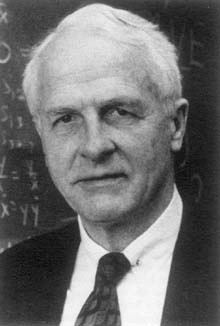
Vladimir Igorevich Arnold was a Soviet and Russian mathematician. While he is best known for the Kolmogorov–Arnold–Moser theorem regarding the stability of integrable systems, he made important contributions in several areas including dynamical systems theory, algebra, catastrophe theory, topology, algebraic geometry, symplectic geometry, differential equations, classical mechanics, hydrodynamics and singularity theory, including posing the ADE classification problem, since his first main result—the solution of Hilbert's thirteenth problem in 1957 at the age of 19. He co-founded two new branches of mathematics—KAM theory, and topological Galois theory.

In mathematics and applied mathematics, perturbation theory comprises methods for finding an approximate solution to a problem, by starting from the exact solution of a related, simpler problem. A critical feature of the technique is a middle step that breaks the problem into "solvable" and "perturbative" parts. In perturbation theory, the solution is expressed as a power series in a small parameter . The first term is the known solution to the solvable problem. Successive terms in the series at higher powers of usually become smaller. An approximate 'perturbation solution' is obtained by truncating the series, usually by keeping only the first two terms, the solution to the known problem and the 'first order' perturbation correction.
In mathematics, a singular perturbation problem is a problem containing a small parameter that cannot be approximated by setting the parameter value to zero. More precisely, the solution cannot be uniformly approximated by an asymptotic expansion

Martin David Kruskal was an American mathematician and physicist. He made fundamental contributions in many areas of mathematics and science, ranging from plasma physics to general relativity and from nonlinear analysis to asymptotic analysis. His most celebrated contribution was in the theory of solitons.

Garrett Birkhoff was an American mathematician. He is best known for his work in lattice theory.
In mathematics, generalized functions are objects extending the notion of functions. There is more than one recognized theory, for example the theory of distributions. Generalized functions are especially useful in making discontinuous functions more like smooth functions, and describing discrete physical phenomena such as point charges. They are applied extensively, especially in physics and engineering.

Kurt Otto Friedrichs was a noted German-American mathematician. He was the co-founder of the Courant Institute at New York University, and a recipient of the National Medal of Science.
Lloyd Nicholas Trefethen is an American mathematician, professor of numerical analysis and head of the Numerical Analysis Group at the Mathematical Institute, University of Oxford.
Numerical linear algebra, sometimes called applied linear algebra, is the study of how matrix operations can be used to create computer algorithms which efficiently and accurately provide approximate answers to questions in continuous mathematics. It is a subfield of numerical analysis, and a type of linear algebra. Computers use floating-point arithmetic and cannot exactly represent irrational data, so when a computer algorithm is applied to a matrix of data, it can sometimes increase the difference between a number stored in the computer and the true number that it is an approximation of. Numerical linear algebra uses properties of vectors and matrices to develop computer algorithms that minimize the error introduced by the computer, and is also concerned with ensuring that the algorithm is as efficient as possible.
Steven Alan Orszag was an American mathematician.
Willard L. Miranker was an American mathematician and computer scientist, known for his contributions to applied mathematics and numerical mathematics.
In scientific computation and simulation, the method of fundamental solutions (MFS) is a technique for solving partial differential equations based on using the fundamental solution as a basis function. The MFS was developed to overcome the major drawbacks in the boundary element method (BEM) which also uses the fundamental solution to satisfy the governing equation. Consequently, both the MFS and the BEM are of a boundary discretization numerical technique and reduce the computational complexity by one dimensionality and have particular edge over the domain-type numerical techniques such as the finite element and finite volume methods on the solution of infinite domain, thin-walled structures, and inverse problems.

Barbara Lee Keyfitz is a Canadian-American mathematician, the Dr. Charles Saltzer Professor of Mathematics at Ohio State University. In her research, she studies nonlinear partial differential equations and associated conservation laws.

Alexander Nikolaevich Varchenko is a Soviet and Russian mathematician working in geometry, topology, combinatorics and mathematical physics.

Wiktor Eckhaus was a Polish–Dutch mathematician, known for his work on the field of differential equations. He was Professor Emeritus of Applied Mathematics at the Utrecht University.

Gheorghe Moroșanu is a Romanian mathematician known for his works in Ordinary and Partial Differential Equations, Operator Theory, Integral Equations, Calculus of Variations and Optimal Control, Fluid Mechanics, Difference Equations, and other branches of Mathematics. He earned his Ph.D. in 1981 from the Alexandru Ioan Cuza University in Iași.
Peter John Olver is a British-American mathematician working in differential geometry.
Wolfgang R. Wasow was an American mathematician known for his work in asymptotic expansions and their applications in differential equations.
Bernard Judah Matkowsky was an American applied mathematician.
Charles (Chuck) William Groetsch is an American applied mathematician and numerical analyst.










